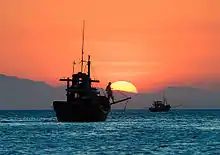Mũi Né
Mũi Né is a coastal fishing town in the south-central Bình Thuan Province of Vietnam. The town, with approximately 25,000 residents, is a ward of the city of Phan Thiết. Mui Ne and the other wards of Phan Thiet stretch along the coast for approximately 50 kilometers and have been transformed into a resort destination since the mid 1990s, when many visited the area to view the solar eclipse of October 24, 1995. Most notably, tourism has developed in the area from the Phan Thiet city center to Mui Ne, which has more than a hundred beach resorts, as well as restaurants, bars, shops and cafes.
Mui Ne
Phường Mũi Né | |
|---|---|
 Fishing boats in Mũi Né harbour | |
| Nickname(s): "The resort capital of Vietnam"[1] "Thủ đô resort của Việt Nam" | |
 Mui Ne Location in Vietnam | |
| Coordinates: 10°56′N 108°17′E | |
| Country | |
| Province | Bình Thuận |
| City | Phan Thiet |
| Population (2005) | |
| • Religions | Buddhism |
Mũi Né ward has two beaches; Ganh Beach and Suoi Nuoc Beach, both with a number of resorts and a few shops and restaurants. But the most highly developed area is Rang Beach in Ham Tien ward (often erroneously called "Mui Ne Beach" by foreigners), which extends west of Mui Ne.
The tourist season is from December to April. The average temperature is 27°C, and the climate is hot and dry much of the year.
Mui Ne is well known for unique white sand dunes, featuring several lakes and even swamps straight in the middle of sandy terrain.
Culture
Cuisine
Mui Ne is famous for seafood. Sand dunes are the inhabited by the iguana, called Dong in Vietnamese. It is a reptile, quite similar to the lizard, but larger and longer. Local people cook iguana in seven ways: grilled, steamed, fried, roasted, raw, served in porridge, iguana pie, and served alongside vegetables. Therefore, the local people call this the seven dishes from iguana.
Gallery
 Hot Air Balloon over white sand dunes
Hot Air Balloon over white sand dunes White sand dunes: view from hot air balloon
White sand dunes: view from hot air balloon Cham Tower at Phu Hai
Cham Tower at Phu Hai Local fishermen
Local fishermen Fisherman at Mũi Né Beach
Fisherman at Mũi Né Beach Fishing at dawn near Mũi Né
Fishing at dawn near Mũi Né Before the storm
Before the storm Mũi Né Fairy Stream
Mũi Né Fairy Stream Kitesurfing on the beach
Kitesurfing on the beach Kitesurfing on the beach
Kitesurfing on the beach Harbour
Harbour Fishing boats in harbour
Fishing boats in harbour Sand dunes
Sand dunes Sand dunes
Sand dunes
